Pyroteuthis margaritifera
Richard E. Young and Katharina M. Mangold (1922-2003)Introduction
P. margaritifera is most easily separated from other members of the genus by the arrangement of photophores in the tentacles and the structure of the hectocotylus.
Characteristics
- Tentacle photophores
- Three large, ellipsoidal photophores (all are double photophores).
- Most distal member well proximal to base of carpal cluster (i.e., distance between this photophore and distal, spherical photophore much greater than distance between distal two ellipsoidal photophores).
- Three smaller, spherical photophores, two at base of tentacular stalk and one at base of club.
- Spherical to ovoid superficial photophore absent.
 Click on an image to view larger version & data in a new window
Click on an image to view larger version & data in a new windowFigure. Schematic illustration of the tentacle of P. margaritifera showing photophores. Drawing by R. Young.
 Click on an image to view larger version & data in a new window
Click on an image to view larger version & data in a new window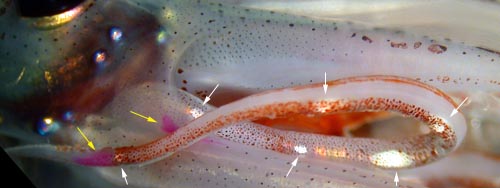
Figure. Tentacle of P. margaritifera (unfixed) with white arrows indicating positions of photophores. The yellow arrows point to violet pigment associated with the basal tentacle and club photophores. In the former, the pigment lies in the extension of the lateral membrane of arm IV which, presumably, covers the photophore under normal conditions. In the later case, the pigment lies in the integument of the aboral surface of the club.
- Three large, ellipsoidal photophores (all are double photophores).
- Hectocotylus (right arm IV) with:
- 13-19 proximal hooks.
- Each proximal hook large with primary cusp bearing smooth inner edge and large, rounded secondary cusp.
- Fleshy, elongate pad (unlike flap in other species) distal to proximal hooks.
- 3 hooks opposite flap.
- 0-13 suckers at tip.
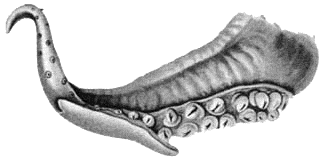
Figure. Medial view of the hectocotylus of P. margaritifera. Drawing from Chun (1910).
Comments
Compare the following structures with other species of Pyroteuthis:
Characters of value for species identification have not yet been recognized on the tentacular club.

Distribution
Vertical distribution
Off Bermuda, P. margaritifera is found mostly at depths of 375-500 m during the day and 75-175 m at night (Roper and Young, 1975.
Geographical distribution
P. margaritifera was first described from the Mediterranean Sea (Rüppell, 1844). It is widely distributed throughout the tropical and temperate Atlantic, Indian and South Pacific Oceans but is absent from the eastern Pacific (Nesis, 1982/87). This map shows the general localities (white circles) where P. margaritifera has been captured. (Distribution records listed here).

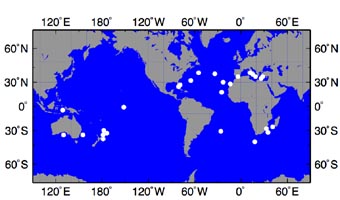
Geographical variation
Specimens taken outside the North Atlantic show considerable variation. Nesis (1982/87) noted the following variation in Pacific Ocean populations in the number of tentacle-photophores:
- Squids from the equatorial and western central Pacific have 6 to 8 photophores (usually 7) but lack the small number 2 photophore.
- Squids from the Kuroshio Current have 6 photophores and lack the small number 2 photophore.
- Squids from southern and southwestern Australian waters have 6 photophores, including the small number 2 photophore.
None of these forms seem to fit P. serrata (Riddell, 1985) which was described subsequent to Nesis' book. The systematic status of these forms is unresolved.
References
Nesis, K. N. 1982. Abridged key to the cephalopod mollusks of the world's ocean. 385+ii pp. Light and Food Industry Publishing House, Moscow. (In Russian.). Translated into English by B. S. Levitov, ed. by L. A. Burgess (1987), Cephalopods of the world. T. F. H. Publications, Neptune City, NJ, 351pp.
Riddell, D. J. 1985. Enoploteuthidae of the New Zealand Region. Fisheries Research Bulletin. New Zealand Ministry of Agriculture and Fisheries, No.27: 1-52.
Roper, C. F. E. and R. E. Young. 1975. Vertical distribution of pelagic cephalopods. Smithsonian Contributions to Zoology, 209: 1-51.
Rüppell, E. 1844. Intorno ad alcuni Cephalopodi del mare di Messina.Messina.
Title Illustrations

| Scientific Name | Pyroteuthis margaritifera |
|---|---|
| Comments | Photographed aboard the R/V G. O. Sars, Mar-Eco cruise, central North Atlantic. |
| Sex | Male |
| View | Ventral |
| Size | 31 mm ML |
| Image Use |
 This media file is licensed under the Creative Commons Attribution-NonCommercial License - Version 3.0. This media file is licensed under the Creative Commons Attribution-NonCommercial License - Version 3.0.
|
| Copyright |
© 2004

|
About This Page

University of Hawaii, Honolulu, HI, USA
Katharina M. Mangold (1922-2003)

Laboratoire Arago, Banyuls-Sur-Mer, France
Page copyright © 2016 and Katharina M. Mangold (1922-2003)
 Page: Tree of Life
Pyroteuthis margaritifera .
Authored by
Richard E. Young and Katharina M. Mangold (1922-2003).
The TEXT of this page is licensed under the
Creative Commons Attribution-NonCommercial License - Version 3.0. Note that images and other media
featured on this page are each governed by their own license, and they may or may not be available
for reuse. Click on an image or a media link to access the media data window, which provides the
relevant licensing information. For the general terms and conditions of ToL material reuse and
redistribution, please see the Tree of Life Copyright
Policies.
Page: Tree of Life
Pyroteuthis margaritifera .
Authored by
Richard E. Young and Katharina M. Mangold (1922-2003).
The TEXT of this page is licensed under the
Creative Commons Attribution-NonCommercial License - Version 3.0. Note that images and other media
featured on this page are each governed by their own license, and they may or may not be available
for reuse. Click on an image or a media link to access the media data window, which provides the
relevant licensing information. For the general terms and conditions of ToL material reuse and
redistribution, please see the Tree of Life Copyright
Policies.
- Content changed 16 November 2016
Citing this page:
Young, Richard E. and Katharina M. Mangold (1922-2003). 2016. Pyroteuthis margaritifera . Version 16 November 2016 (under construction). http://tolweb.org/Pyroteuthis_margaritifera/19758/2016.11.16 in The Tree of Life Web Project, http://tolweb.org/




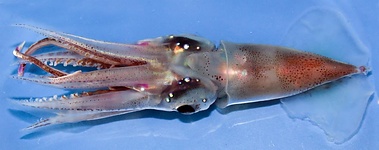
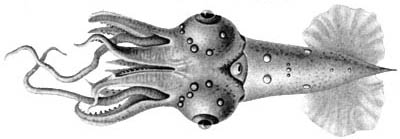
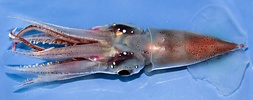
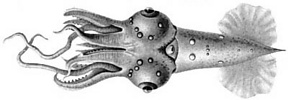


 Go to quick links
Go to quick search
Go to navigation for this section of the ToL site
Go to detailed links for the ToL site
Go to quick links
Go to quick search
Go to navigation for this section of the ToL site
Go to detailed links for the ToL site